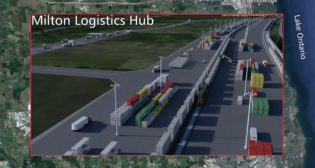
Grade crossings get smarter, safer
Written by Nebraska Digital, administratorCurrent technology is not only more reliable, it’s highly intelligent.
When it comes to grade crossings, protecting people and equipment is the top priority for all railroads. Suppliers are making that job easier by ensuring everything from the bells and lights to the communications mechanisms are all focused toward one goal: safety. For their part, manufacturers are making gate arms that are stronger, LEDs that are more energy efficient, and communications systems that offer faster information exchange.
Ansaldo STS USA
Ansaldo STS USA, Inc., offers the Model 95 Highway Gate Crossing Mechanism. The company says the mechanism provides top-quality performance in a variety of crossing configurations, including standard highway crossings, highway crossings combined with pedestrian gates, and highway crossing four-quadrant gate systems with entrance and exit gate mechanisms.
“The reengineered design offers our customers a simple, reliable and durable mechanism, built with both safety and value in mind,” says Russell Glorioso, marketing communications manager at Ansaldo STS USA. “It can be outfitted with either a relay (vital or non-vital) for motor control or with the new electronic motor controller, which provides a test button feature and LED indicator to quickly check functionality of the gate mechanism. Like all Ansaldo STS USA products, the Model 95 Gate Mechanism is backed by our USA R.A.I.L. (Rapid Action Information Link) Team, providing support 24 hours a day, seven days a week.”
GE Transportation
At GE Transportation Rail, the goal of simplification drives the company’s developments. “Our PTC solutions are designed to reduce the effort required to upgrade existing locations, as well as deploy new locations,” says Tom Scott, GE Transportation communications leader. “We also continue to refine our diagnostics and configuration tools to ensure they’re easy to use and are taking advantages of ever-increasing opportunities for remote accessibility.”
GE’s ElectroLogIXS XP4 grade crossing system is part of the ElectroLogIXS family of control systems. Because the XP4 uses the same vital processor as the ElectroLogIXS interlocking and signaling products, Scott notes that the company is fully prepared to support PTC for crossings as the requirement for this function evolves. In addition, GE has integrated crossing control technology into ITCS (Incremental Train Control System) to perform crossing activation at speeds up to 110 mph.
Scott says the GE product line has evolved to reflect the interest in transit. “In addition to leveraging the proven technology of our interlocking, crossing, and signaling products, ElectroLogIXS brings a level of scalability and flexibility perfectly suited for transit applications,” he says. “Through these attributes, ElectroLogIXS can easily adapt to systems of varying complexity and the unique requirements of individual agencies.”
Invensys Rail
Invensys Rail Corp. has several new features that have been added to its fully integrated crossing-control system, the Grade Crossing Predictor (GCP) 4000. The GCP 4000 system now uses audio frequency, phase-shift-overlay track circuits for operation in electrified territories.
According to Invensys Rail, this addition brings the concept and advantages of a fully-integrated crossing system, with main and standby functionality, to mass transit applications.
Bidirectional DAXing, a GCP 4000 exclusive, allows bidirectional outer crossing locations to DAX to inner crossings via a coded overlay track circuit, a hard-wired connection, or a wireless connection. The company notes that this reduces the open frequency spectrum for inner crossings through the use of higher channels and reduces costs by eliminating use of signal cut sections. Invensys Rail also points out that speed increases are more easily made because only the outer crossings require approach length increases.
The time required for Annual Warning Time testing has been significantly reduced. Conducting an internal track shunt simulation of a train movement and recording specified configuration parameters, settings, and measurements at the time of installation or modification establishes a crossing baseline stored in the GCP. An annual comparison to the baseline confirms that the crossing remains as originally configured.
The company notes that the GCP 4000 will continue to evolve to meet the needs of PTC, especially as the interoperable PTC specifications expand to include operation of the grade crossing. Invensys Rail is working to insure that the GCP 4000 will support all physical and logical interfaces required for PTC interoperability in the future. Similarly, Invensys Rail is working to offer the same ability to upgrade existing crossing systems, such as GCP 3000, that are in wide use today.
“Industry R&D efforts have expanded principally in reaction to the PTC mandate for 2015,” Invensys Rail says. “PTC systems, existing and new, are being refined to meet the recently published PTC specifications. Existing, installed communications and signal systems must be integrated into the PTC structure and interoperability between suppliers must be achieved.”
National Electric Gate
National Electric Gate Co. has a constantly evolving product line to meet customer specifications and requirements. Marty Peterson, Jr., director of operations, notes the company is currently at work on a quick-connect gate assembly that eliminates the need for through bolts by utilizing a vice shield between sections. “The idea behind this was simplicity, lowering cost and saving time when it comes to maintaining and installing,” says Peterson. “On this particular project, we’ve been working with one of the Class I railroads to perfect it. We are also having it tested in the field.”
The company calls its one-watt LED light the most durable LED in the marketplace. This LED light is voltage regulated to share voltage between incandescents and LEDs so that users can retrofit without changing all bulbs in a light set at one time. The LEDs have a service life of 100,000 hours, are water-resistant, 100% shockproof, and are constructed from durable material, as well as tested and approved by the Class I railroads.
The Gate-Saver 2-WAY, a heavy-duty conversion bracket, allows the gate arm to be struck in the down position and in either direction. The gate will swing away, then return to its original position. “This has saved the railroads time and money on lower maintenance costs for gates and labor,” says Peterson. “If a gate gets hit, the Gate-Saver will return the gate to its original position. As long as the gate isn’t hit at 30 mph or faster, it will remain intact, most likely in normal operating condition.”
The Gate-Saver 2-WAY also has the same maintenance modifications as the original Gate-Saver, thus allowing the maintainer or supervisor to move the gate off to the side of the road without disconnecting it from the mechanism. When the mechanism or gate arm requires service, a maintainer can release two bolts on the Gate-Saver, which allows the gate to swing off to the side of the road and out of the middle of traffic. “At National Electric Gate, safety is our driving force,” says Peterson.
“We look toward the safety of the railroad signal maintainer and every pedestrian and motorist that moves across railroad crossings. When it comes to anything we design or manufacture, we must incorporate safety features, thus creating a safer product for the rail industry.”
Western-Cullen-Hayes
Western-Cullen-Hayes, Inc., soon will be introducing the 3598 crossing gate mechanism,which uses an electro-magnetic brake to hold the gate arm in the vertical position, instead of the traditional “hold clear” device. Sales Manager Carl Pambianco says the advantage of the brake is that it eliminates the maintenance cost associated with a hold clear and requires virtually no maintenance or adjustment. The 3598 is undergoing field testing and should be ready for production in the very near future.
“WCH has seen a general uptick in business as a result of the increased funding of rail-related projects,” says Pambianco. “We are hopeful this trend will continue. As these projects come on line, we are confident the economic and environmental benefits of investing in rail transportation will be self-evident.”



